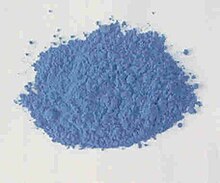埃及藍
外觀
| 埃及藍 | |
|---|---|
| 網頁顏色 | #1034A6 |
| RGBB (r, g, b) | (16, 52, 166) |
| CMYH (c, m, y) | (94, 80, 35) |
| CMYKH (c, m, y, k) | (90, 69, 0, 35) |
| HSL (h, s, l) | (226°, 82%, 36%) |
| HSV (h, s, v) | (226°, 90%, 65%) |
| HWB (h, w, b) | (226°, 6%, 35%) |
| B:代表值域介於0~255之間 | |
| H:代表值域介於0~100之間 | |

埃及藍,或稱矽酸銅鈣(CaCuSi4O10或CaOCuO(SiO2)4),是源於古埃及的一種藍色合成顏料,被認為是人類歷史上最早的人工合成顏料。[1]

根據孟菲斯大學埃及學家洛爾萊·科科倫(Lorelei H. Corcoran)的研究,埃及藍的使用可以追溯到埃及前王朝奈加代三期文化時期。[2]埃及語中稱這種顏料為「ḫsbḏ-ỉrjt」,意為「人造青金石」,即是指發明此種顏料的目的是替代昂貴的青金石(ḫsbḏ)顏料。[3]埃及藍後來流傳至歐洲,在古羅馬有廣泛使用,羅馬人稱之為「caeruleum」(蔚藍色)。但此後埃及藍逐漸消失,相關製作技術也隨之亡佚。[4]
漢弗里·戴維等近現代科學家對埃及藍顏料做了化學鑑定分析,並還原了其製備方式。[5][6]
參見
[編輯]參考文獻
[編輯]- ^ Eastaugh, Nicholas; Walsh, Valentine; Chaplin, Tracey; Siddall, Ruth. Egyptian blue. The pigment compendium: Optical microscopy of historical pigments. Oxford, UK: Elsevier Butterworth Heinemann: 147–148. 2004.
- ^ Lorelei H. Corcoran, "The Color Blue as an 'Animator' in Ancient Egyptian Art", in Rachael B.Goldman, (ed.), Essays in Global Color History: Interpreting the Ancient Spectrum (New Jersey: Gorgias Press, 2016), pp. 59–82.
- ^ Pagès-Camagna, S. (1998). "Bleu et vert égyptiens en question: vocabulaire et analyses". In Colinart S, Menu M, eds., La couleur dans la peinture et l'émaillage de l'Egypte Ancienne, CUEBC, Ravello, 20–22 March 1997, Edipuglia, Bari, pp. 51–59.
- ^ McCouat, Philip. Egyptian blue: The colour of technology. artinsociety.com. Journal of Art in Society. 2018 [2019-05-29]. (原始內容存檔於2019-03-28).
- ^ Sir Humphry Davy (1815), "Some experiments and observations on the colours used in painting by the ancients" (頁面存檔備份,存於互聯網檔案館), Philosophical Transactions of the Royal Society of London, vol. 105, pages 97–124. Reprinted in: The Collected Works of Sir Humphry Davy, ... (London, England: Smith, Elder, and Co., 1840), vol. VI, pp. 131–159.
- ^ Tite, M.S., Bimson, M. & Cowell, M.R. The technology of Egyptian blue. M. Bimson; I.C. Freestone (編). Early Vitreous materials. British Museum occasional paper 56. London: British Museum. 1987. ISBN 978-0-86159-056-8.
